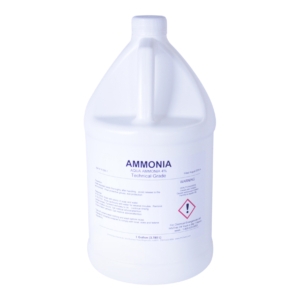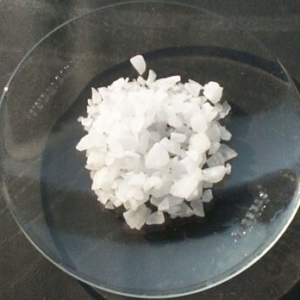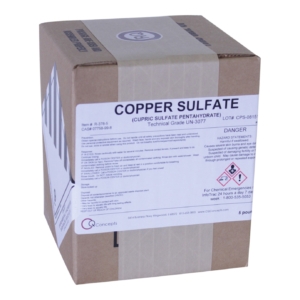Description
Boric Acid
From Wikipedia, the free encyclopedia
Boric acid, also called boracic acid or orthoboric acid or Acidum Boricum, is a mild acid often used as an antiseptic, insecticide, flame retardant, in nuclear power plants to control the fission rate of uranium, and as a precursor of other chemical compounds. It exists in the form of colorless crystals or a white powder and dissolves in water. It has the chemical formula H3BO3, sometimes written B(OH)3. When occurring as a mineral, it is called sassolite.
Preparation
Boric acid is produced mainly from borate minerals by the reaction with sulfuric acid. The largest source of borates in the world is an open-pit mine in Boron, California, USA.
Properties
Boric acid was first prepared by Wilhelm Homberg (1652-1715) from borax, by the action of mineral acids, and was given the name sal sedativum Hombergi. The presence of boric acid or its salts has been noted in sea-water, whilst it is also said to exist in plants and especially in almost all fruits (A. H. Allen, Analyst, 1904, 301). The free acid is found native in certain volcanic districts such as Tuscany, the Lipari Islands and Nevada, issuing mixed with steam from fissures in the ground; it is also found as a constituent of many minerals (borax, boracite, boronatrocaicite and colemanite).Boric acid is soluble in boiling water. When heated above 170?C it dehydrates, forming metaboric acid HBO2. Metaboric acid is a white, cubic crystalline solid and is only slightly soluble in water. It melts at about 236?C, and when heated above about 300?C further dehydrates, forming tetraboric acid or pyroboric acid, H2B4O7. Boric acid can refer to any of these compounds. Further heating leads to boron trioxide.
Boric acid does not dissociate in aqueous solution, but is acidic due to its interaction with water molecules:
B(OH)3 + H2O ? B(OH)4– + H+
Ka = 5.8×10-10 mol/l; pKa = 9.24.
Polyborate anions are formed at pH 7?10 if the boron concentration is higher than about 0.025 mol/L. The best known of these is the tetraborate ion, found in the mineral borax:
4B(OH)4- + 2H+ ? B4O72- + 9H2O
Toxicology
While strictly speaking, Boric Acid is poisonous if taken internally or inhaled, it is generally not considered to be much more toxic than table salt (based on its mammal LD50 rating of 2660mg/kg body mass).[1][this source’s reliability may need verification]. The Thirteenth Edition of the Merck Index indicates that the LD50 of boric acid is 5.14 g/kg for oral dosages given to rats, and that 5 to 20 g has produced death in adult humans. The LD50 of sodium chloride is reported to be 3.75 g/kg in rats according to the Merk Index. According to the Dutch Health Council(1998/19) Boric Acid should be regarded as if it impairs fertility in humans (R60).
Uses
Insecticidal use
It is often used as a relatively nontoxic insecticide, for killing cockroaches, termites, fire ants, fleas, and many other insects. It can be used directly in powdered form for fleas and cockroaches, or mixed with sugar or grape jelly for ants. It is also a component of many commercial insecticides. In this use, especially in the case of cockroaches, the boric acid in the form of a powder is applied to areas frequented by the insects. As an insecticide, boric acid’s mechanism of action is not fully known– it may involve destruction of the foregut lining of cockroaches, possibly causing starvation (PMID 7607296). Boric acid for this use in residential apartments is sold commercially in urban areas afflicted with cockroaches. (Insect control ref: [2])
Industrial uses
Boric acid is used in nuclear power plants to slow down the rate at which fission is occurring. Fission chain reactions are generally driven by the amount of neutrons present (as products from previous fissions). Boron has a high cross-section for absorption of neutrons and is therefore dissolved into the primary coolant which circulates through the reactor. By changing the concentration of boric acid in the water, fission can be regulated. Boron is also dissolved into the spent fuel pools containing used uranium rods. The concentration is high enough to keep fissions at a minimum. In the jewelry industry, boric acid is often used in combination with denatured alcohol to reduce surface oxidation and firescale from forming on metals during annealing and soldering operations.
It is also used in the manufacturing of remming mass, a fine silica-containing powder used for producing induction furnace linings and ceramics.
Miscellaneous uses
Borates including boric acid have been used since the time of the Greeks for cleaning, preserving food, and other activities.
Silly Putty was originally made by adding boric acid to silicone oil. Now name-brand Silly Putty also contains significant amounts of elemental silicon (silicon binds to the silicone and allows the material to bounce 20% higher).
Lithium boric acid is the lithium salt of boric acid and is used in the laboratory as buffer for gel. TBE buffer is widely used for the electrophoresis of nucleic acids and has a higher buffer capacity than a TAE Buffer. It can be used for DNA and RNA polyacrylamide and agarose gel electrophoresis.
It is used in pyrotechnics to prevent the amide-forming reaction between aluminum and nitrates. A small amount of boric acid is added to the composition to neutralize alkaline amides that can react with the aluminum.
Boric acid is popularly used among fire jugglers and fire spinners dissolved in methylated spirit to give a bright green flame.
It is also used in India and across the world to dust down Carrom Boards to decrease friction and increase speed of play.






